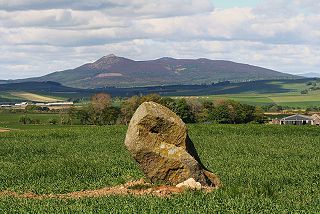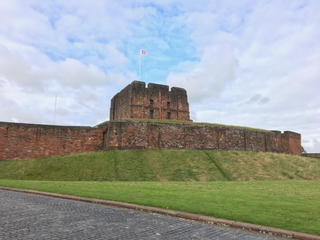| |||||
| Centuries: | |||||
|---|---|---|---|---|---|
| Decades: | |||||
| See also: | List of years in Scotland Timeline of Scottish history 1316 in: England • Elsewhere | ||||
Events from the year 1316 in the Kingdom of Scotland .
| |||||
| Centuries: | |||||
|---|---|---|---|---|---|
| Decades: | |||||
| See also: | List of years in Scotland Timeline of Scottish history 1316 in: England • Elsewhere | ||||
Events from the year 1316 in the Kingdom of Scotland .
Year 1316 (MCCCXVI) was a leap year starting on Thursday of the Julian calendar.

The Wars of Scottish Independence were a series of military campaigns fought between the Kingdom of Scotland and the Kingdom of England in the late 13th and early 14th centuries.

Robert II was King of Scots from 1371 to his death in 1390. He was the first monarch of the House of Stewart as the son of Walter Stewart, 6th High Steward of Scotland, and of Marjorie Bruce, daughter of the Scottish king Robert the Bruce by his first wife Isabella of Mar.

The Battle of Harlaw was a Scottish clan battle fought on 24 July 1411 just north of Inverurie in Aberdeenshire. It was one of a series of battles fought during the Middle Ages between the barons of northeast Scotland against those from the west coast.

Earl of Carrick or Mormaer of Carrick is the title applied to the ruler of Carrick, subsequently part of the Peerage of Scotland. The position came to be strongly associated with the Scottish crown when Robert the Bruce, who had inherited it from his maternal kin, became King of the Scots in the early 14th century. Since the 15th century the title of Earl of Carrick has automatically been held by the heir apparent to the throne, meaning Prince Charles is the current Earl.

Carlisle Castle is in Carlisle, in the English county of Cumbria, near the ruins of Hadrian's Wall. The castle is over 900 years old and has been the scene of many historical episodes in British history. Given the proximity of Carlisle to the border between England and Scotland, it has been the centre of many wars and invasions. During the Jacobite Rising of 1745–6, Carlisle became the last English fortress to undergo a siege. The castle was listed as a Scheduled Ancient Monument on 7 August 1996.
Humphrey (VII) de Bohun, 4th Earl of Hereford was a member of a powerful Anglo-Norman family of the Welsh Marches and was one of the Ordainers who opposed Edward II's excesses.

Marjorie Bruce or Marjorie de Brus was the eldest daughter of Robert the Bruce, King of Scots, and the only child born of his first marriage with Isabella of Mar.
Walter Stewart was the 6th Hereditary High Steward of Scotland and was the father of King Robert II of Scotland, the first Stewart monarch.
The Battle of Faughart was fought on 14 October 1318 between a Hiberno-Norman force led by John de Bermingham and Edmund Butler, Earl of Carrick, and a Scottish and Irish army commanded by Prince Edward Bruce, Earl of Carrick, brother of King Robert I of Scots. It was a battle of the First War of Scottish Independence and more precisely the Irish Bruce Wars. The defeat and death of Bruce at the battle ended the attempt to revive the High Kingship of Ireland. It also ended, for the time being, King Robert's attempt to open up a second front against the English in the Wars of Scottish Independence.

Berwick Castle is a ruined castle in Berwick-upon-Tweed, Northumberland, England.

Fetteresso Castle is a 14th-century tower house, rebuilt in 1761 as a Scottish Gothic style Palladian manor, with clear evidence of prehistoric use of the site. It is situated immediately west of the town of Stonehaven in Kincardineshire, slightly to the west of the A90 dual carriageway. Other notable historic fortified houses or castles in this region are Dunnottar Castle, Muchalls Castle, Fiddes Castle, Cowie Castle and Monboddo House.
Sir Niall mac Cailein, also known as Neil Campbell or Nigel Campbell, was a nobleman and warrior who spent his life in the service of King Robert I of Scotland, His Gaelic name means "Niall, Colin's son" since he was the son of Cailean Mór. His services to the King elevated the Campbells into the higher ranks of the Scottish nobility.

Robert Wishart was Bishop of Glasgow during the Wars of Scottish Independence and a leading supporter of Sir William Wallace and King Robert Bruce. For Wishart and many of his fellow churchmen, the freedom of Scotland and the freedom of the Scottish church were one and the same thing. His support for the national cause was to be of crucial importance at some critical times.
Events from the 1310s in England.
John of Argyll, was a Scottish nobleman of the early 14th century. He is often known to today as John Bacach, "the Lame", but there is no authority for that as a contemporary or near-contemporary nickname.
The Battle of Skerries, also named the Battle of Ardscull, was a battle in the Bruce campaign in Ireland – part of the First War of Scottish Independence – fought on 26 January 1316, resulting in a Scottish victory. It was part of the Irish campaign of Edward Bruce, brother of Robert Bruce, king of Scotland. The site of the battle was Skerries near Ardscull in County Kildare.
The Battle of Skaithmuir was a skirmish of the First War of Scottish Independence. It took place near Coldstream, on the Anglo-Scottish border, in February 1316. The skirmish was fought between the Scottish captain Sir James Douglas, and an English raiding party from Berwick upon Tweed. The English were having difficulty getting supplies to Berwick after the Scots had won back the surrounding territory and the garrison was facing starvation. Under Edmond Caillou, a Gascon knight, about 80 men set out from Berwick to raid Teviotdale for cattle. Douglas, having been informed that there were fewer in the raiding party, set out to cut them off. Douglas won, and Caillou was killed. Douglas later called it the most difficult fight of his long career. The Scots under Douglas and Thomas Randolph went on to capture Berwick in April 1318.

Simon de Montagu, 1st Baron Montagu was summoned to Parliament by writ and thereby became the 1st Baron Montagu. He was the ancestor of the great Montagu family, Earls of Salisbury.
Admiral Sir Robert Morley or Robert de Morley, 2nd Baron Morley, was an English Knight and naval officer who served as Admiral of the North four times from in the service of King Edward III.